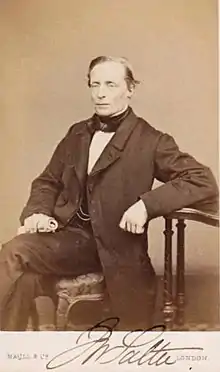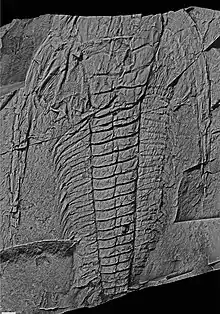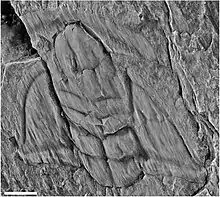
John William Salter (15 December 1820 – 2 December 1869) was an English naturalist, geologist, and palaeontologist.
Salter was apprenticed in 1835 to James De Carle Sowerby, and was engaged in drawing and engraving the plates for Sowerby's Mineral Conchology, the Supplement to Sowerby's English Botany, and other natural history works.[1] In 1842, he was employed for a short time by Adam Sedgwick in arranging the fossils in the Woodwardian Museum at Cambridge, and he accompanied the professor on several geological expeditions (1842–1845) into Wales.
Salter was born in Pratt Place, Camden Town, the son of John Salter (1779–1837), a banking clerk, and his wife, Mary Ann. His birth was registered at Dr. William's Library near Cripplegate, London. In 1846, Salter married Sally, daughter of James De Carle Sowerby, and eventually fathered seven children with her. Also in 1846, Salter was appointed on the staff of the Geological Survey and worked under Edward Forbes until 1854. He succeeded Forbes as palaeontologist to the survey and gave his chief attention to the Palaeozoic fossils, spending much time in Wales and the border counties. He contributed the palaeontological portion to Andrew Crombie Ramsay's Memoir on the Geology of North Wales (1866), assisted Roderick Murchison in his work on Siluria (1854 and later editions),[2] and Adam Sedgwick by preparing A Catalogue of the Collection of Cambrian and Silurian Fossils contained in the Geological Museum of the University of Cambridge (1873).[3]

In the very early 1860's, whilst collecting fossils in South West Wales as part of his duties for the British Geological Survey, Salter was examining coastal exposures by boat around the St Davids peninsula and landed in the small inlet of Porth-y-rhaw, in the mistaken belief that it was Solva Harbour a short distance to the east. In 1862, whilst investigating the eastern cliff section and in strata now known as the Menevia Formation (Rees et al., 2014, p. 73)[4] Salter discovered remains of one of the largest trilobites ever found (over 50 cm long) and which, in 1863, he named Paradoxides davidis after his friend David Homfray (1822–1893), an amateur fossil collector from Porthmadog, North West Wales.[5] For many years and up to the time of his death, Homfray was Clerk to the Justices of the Peace for the Penrhyndeudraeth Division.
Encouraged by Salter, Homfray made many important fossil discoveries in the Porthmadog district, Gwynedd, especially within the Tremadocian rocks, and Salter named several species after Homfray to honour his efforts, e.g. Niobe (Niobella) Homfrayi (Salter, 1866, p. 143, pl. 20, fig. 9.),[6][7][8] Asaphus Homfrayi Salter (1866)[9] – now Asaphellus homfrayi (Salter) – see Morris (1988): Lectotype,[10] from Garth Hill, near Porthmadog, and Conularia Homfrayi Salter; undifferentiated Type, also from Garth Hill. [(Salter 1866, p. 354, pl. 10, fig. 11); Salter (1873, p. 18, p. 323); Woods, H. (1891, p. 119)].[11]
From the Clogau Formation of Waterfall Valley near Maentwrog, Homfray also discovered for the first time in Britain, Conocoryphe coronata Barrande, 1846,[12] and another species named in his honour, "Conocoryphe" Homfrayi Salter,[13][14] subsequently assigned to Ptychoparia, Hawle and Corda, 1847.[15]
In 1865 Salter collaborated with Henry Woodward to produce a Chart of Fossil Crustacea.[16] and in the same year published a paper on some Additional Fossils from the Lingula-Flags.[17] in which he named several trilobite species that were subsequently described by Hicks (1872).
Salter prepared several of the Decades of the Geological Survey and became the leading authority on trilobites. He resigned his post on the Geological Survey in 1863 and committed suicide on 2 December 1869 by throwing himself into the Thames.[18] He was buried on the eastern side of Highgate Cemetery in an unmarked grave (no.15356). At the time of his death he had barely completed the illustrated 'Catalogue of Cambrian and Silurian Fossils' (q.v.) in the Woodwardian Museum and he left unfinished a 'Monograph of British Trilobites,’ published by the Palæontographical Society (1864–1867).
He was elected an associate of the Linnean Society in 1842, made a fellow of the Geological Society of London (FGS) in 1846, and in 1865 was awarded the Wollaston donation-fund by the Geological Society.
Fossils named in honour of John William Salter
Problematica
- Salterella Billings, 1861.[19] An enigmatic early Cambrian genus questionably assigned to extinct phylum Agmata? and family Salterellidae Walcott, 1886.[20] The genus is characterized by a small calcareous, apparently septate conical shell and lends its name to the Salterella Grit Member of the An t-Sron Formation which forms a narrow, discontinuous belt, extending along the North-western side of Scotland.
Trilobites
- Salteria Wyville Thomson, 1864[21] [Family: Raphiophoridae]. Type species, by monotypy, Salteria primaeva Thomson, 1864. Balclatchie Group (Caradoc Series) of the Girvan district, Strathclyde, Scotland.[22]
- Salterolithus Bancroft, 1929[23] [Family:Trinucleidae]. Type species: Trinucleus Caractaci Murchison, 1839. Harnagian, Welshpool, Powys, Wales.[24]
- Salterocoryphe salteri (Rouault, 1851)[25] [Family: Calymenidae]. Middle Ordovician (Dapingian – Darriwilian)], upper part of the Valongo Formation in Northern Portugal; the Llanvirnian at Guadarranque in Cadiz (Andalusia), Spain and; the 'Llandeilo' south of Rennes in Brittany.[26]


- Clarella salteri (Hicks in Salter 1865) [Family: Centropleuridae]. Menevia Formation, Pt. punctuosus Biozone, Porth-y-rhaw, St David's, Dyfed, Wales.
- Cnemidopyge Salteri Hicks MS (Salter 1873, p. 22) [Family: Raphiophoridae]. Penmaen Dewi Formation (Whitlandian), middle Arenig Series of Pwlluog, N end of Whitesands Bay, near St David's, Dyfed, Wales.
- Flexicalymene (Onnicalymene) salteri Bancroft, 1949 [Family: Calymenidae]. Acton Scott Beds (Actonian, Marshbrook, Shropshire, England.[27]
- Leptoplastides salteri (Callaway, 1877) [Family: Olenidae]. Sheinton Shales (Tremadocian Stage) of Sheinton, Shropshire, England.[28]
- Robergiella salteri (Reed, 1899) [Family: Remopleuridae]. Tramore Limestone Formation, ('Llandeilo' and Caradoc Series) of Tramore, County Waterford, Republic of Ireland.[29]
- Oryctocephalus salteri Reed, 1910[30] [Family: Oryctocephalidae]. Wuliuan stage in north side of the Parahio River, Spiti region, India. Parahio Formation, Oryctocephalus salteri Zone.[31]
- Phacops (Viaphacops) salteri Kozlowski, 1923 (p. 54 – 56 pl. 6, fig. 5) [Family: Phacopidae][32] From the Devonian of Bolivia and Columbia.[33]
- Lotagnostus salteri Westrop and Landing, 2017[34] [Family: Agnostidae]. From the Chelsey Drive Group, north shore of East Bay, Cape Breton Island, Nova Scotia, Ctenopyge tumida Zone.
Brachiopoda
- Broeggeria salteri (Holl, 1865)[35] [Family: Elkaniidae]. Obolella salteri Holl, 1865 is type species of the Cambrian lingulid genus Broeggeria Walcott, 1902[36] and is recorded from the Whiteleaved-Oak Shales (Tremadocian) near Malvern, England.
- Salopia salteri (Davidson, 1869) [Family: Linoporellidae]. From the Horderley Sandstone Formation (upper Sandbian), Horderley. Shropshire, England.[37]
- Spiriferella salteri Tschernyschew, 1902[38] [Family: Spiriferellidae]. From the Wordian and Capitanian (Permian) of China and British Columbia, Canada.
Bivalvia
Gastropoda
- Cyrtostropha salteri Ulrich and Scofield 1897[40] [Family: Murchisoniidae]. From the Ordovician of Canada, Greenland and the United States.
Eurypterida
- Salteropterus Kjellesvig-Waering, 1951 [Family: Hughmilleriidae].[41] Named as a species of Eurypterus by Salter in 1859.[42]
- Parahughmilleria salteri Kjellesvig-Waering, 1961 [Order: Eurypterida].[43] Reported from the Temeside Mudstone Formation (Přídolí epoch) of Ludlow and Perton in the Welsh Borders and South Staffordshire.[44]
- Peltocaris salteriana Jones & Woodward, 1893 [Subclass: Phyllocarida].[45] From the Tremadocian Stage (Cressagian), Gwynedd, Wales.
Ophiuroidea
- Salteraster Stürtz 1893 [Family: Urasterellidae].[46][47] Type species; Urasterella asperrimus Salter 1857.[48]
- Stenaster salteri Billings, 1858 [Class: Ophiuroidea]. From the Ordovician of Cardin quarry, Simcoe County, Kirkfield, Ontario, Canada.[49]
Thyestiida
The thyestidians (Thyestiida) are an order of bony-armored jawless fish in the extinct vertebrate class Osteostraci and including the poorly understood osteostracan genus Auchenaspis Egerton, 1857.[50]
- Auchenaspis salteri Egerton (1857, p. 286, pl. 9, figs 4 – 5)[51] [Subphylum: Vertebrata]. The species is known from the Ledbury Formation (Red Downton Formation) of Ledbury, Herefordshire and Ludlow, Shropshire. Přídolí, i.e. the uppermost Silurian.[52]
Graptolithina
A subclass of the class Pterobranchia, the members of which are known as graptolites.
- Callograptus? salteri Hall. 1865[53] [Family: Dendrograptidae]. From the 'Arenigian' of Shropshire and Wales and occurring as far afield as China and Tasmania.[54]
See also
References
- ↑ Professor Huxley (1870). "The Anniversary Address of the President". Quarterly Journal of the Geological Society. 26 (1–2): xxix–lxiv. doi:10.1144/GSL.JGS.1870.026.01-02.04. S2CID 129714077.
- ↑ MURCHISON, R. I. 1854. Siluria. The History of the Oldest known Rocks containing Organic Remains, with a Brief Sketch of the Distribution of Gold over Earth. John Murray, London, 523 pp.
- ↑ SEDGWICK, A. 1873 (in SALTER J. W.). A Catalogue of the Collection of Cambrian and Silurian Fossils Contained in the Geological Museum of the University of Cambridge. University Press, Cambridge
- ↑ REES, A. J., THOMAS, A. T., LEWIS, M., HUGHES, H. E. & TURNER, P. 2014. The Cambrian of S W Wales: Towards a United Avalonian Stratigraphy. Geological Society, London, Memoirs, 42, 1–30.
- ↑ SALTER, J. W. 1863. On the Discovery of Paradoxides in Britain. Quarterly Journal of the Geological Society, London, 19, 274–277.
- ↑ SALTER, J. W. 1866. Palaeontographical Society Monographs (1), pp. 129 – 176, pls. 15 – 25.
- ↑ SALTER 1873. Catalogue of the Cambrian and Silurian fossils contained in the Geological Museum of the University of Cambridge (2): p.15.
- ↑ WOODS, H. 1891. Catalogue of the Type Fossils in the Woodwardian Museum, Cambridge. Henry Woods with preface by T. McKenny Hughes CUP. 180 + xiv SPL: II. 16 (3): p.148.
- ↑ SALTER J. W. 1866 . The geology of North Wales. Memoirs of the Geological Survey of England and Wales. vol. iii (1st edition) (1): p.354 pl. 10 fig. 11.
- ↑ MORRIS, S. F. 1988. A review of British trilobites, including a synoptic revision of Salter's monograph. Palaeontogr. Soc. (Monogr.), 1–316. pp. 26, 255.
- ↑ SLATER, I. L. 1907. A monograph of British Conularae Palaeontographical Society Monographs (4): p. 1.
- ↑ BARRANDE, J. 1846. Notice pre Âliminaire sur le syste Áme silurien et les trilobites de Bohême. Leipzig, 97 pp.
- ↑ Hicks, H. 1872. On some undescribed species from the Menevian Group with a note on the Entomostraca, by Prof. T. Rupert Jones F. G. S. Quarterly Journal of the Geological Society, London, 28, 173 – 185.
- ↑ LAKE, 1932. A monograph of the British Cambrian Trilobites. Palaeontographical Society Monographs pt. vii (4): p.151 pl. xix fig. 7.
- ↑ HAWLE, J. & CORDA, A. J. C. 1847. Prodrom einer Monographieder bohmischen Trilobiten. 176 pp. J. G. Calve, Prague.
- ↑ Chart of Fossil Crustacea. By J. W. SALTER and H. WOODWARD. With Descriptive Catalogue. Lowry & Tennant: London. 1865. The Annals and magazine of natural history; zoology, botany, and geology, 16, series 3, pp. 362–364
- ↑ SALTER, J. W. 1865. On some Additional Fossils from the Lingula-Flags. By J. W. Salter, Esq., A. L. S., F. G. S. With a Note on the genus Anopolenus; by Henry Hicks, Esq. M. R. C. S.
- ↑ SECORD, J. A. (1985). "John W. Salter: The rise and fall of a Victorian palaeontological career". Archives of Natural History. 1: 61–75. doi:10.3366/anh.1985.007.
- ↑ BILLINGS, E. H. (1861). "On some new or little known species of lower Silurian fossils from the Potsdam Group (Primordial zone)". Palaeozoic Fossils. 1 (1): 1–18.
- ↑ Charles Doolittle Walcott (1886). Second contribution to the studies on the Cambrian faunas of North America. Vol. 30 of Geological Survey bulletin. Govt. Print. Off. pp. 1–369.
- ↑ THOMSON, C. W. 1864. Figures and descriptions illustrative of British organic remains. Memoir of the Geological Survey of the United Kingdom. Dec 11, 4 pp., pl. 6.
- ↑ TRIPP, R. P. 1980. Trilobites from the Ordovician Balclatchie and lower Ardwell groups of the Girvan district, Scotland. Transactions of the Royal Society of Edinburgh 71: 123 – 145.
- ↑ BANCROFT, B. B. 1929. Some new species of Cryptolithus (s. l.) from the upper Ordovician. Memoir and Proceedings of the Manchester Library and Philosophical Society , no 73, pp. 67 – 98, pls. 1, 2.
- ↑ MURCHISON, R. I. 1839. The Silurian System. 786 pp., 37 pls. London.
- ↑ ROUAULT, M. 1851. Mémoire sur le terrain paléozoïque des environs de Rennes. Bulletin de la Societe' Géologique de France, 8, 358 – 399.
- ↑ ROMANO, M. 1991. Trilobites from the Ordovician of Portugal. Palaeontology, 34 (2), pp. 329 – 355, 4 pls.
- ↑ BANCROFT, B. B. 1949. Upper Ordovician trilobites of zonal value in south-east Shropshire (Edited by A. Lamont). Proc. R. Soc. (B), 136, pp. 291 – 315, pls. 9 – 11.
- ↑ CALLAWAY, C. 1877. On a new area of Upper Cambrian rocks in South Shropshire, with a description of a new fauna. Quarterly Journal of the Geological Society of London, 33, pp. 652 – 672, pl. 24.
- ↑ REED, F. R. C. 1899. The Lower Palaeozoic bedded rocks of County Waterford. Quarterly Journal of the Geological Society of London, 55, pp. 718 – 772, pl. 44.
- ↑ REED, F. R. C. 1910. The Cambrian fossils of Spiti. Memoirs of the Geological Survey of India, Palaeontologia Indica 15th Series, 7: 1 – 70
- ↑ PENG, S., HUGHES, NIGEL C., HEIM, N. A., SELL, B. K., ZHU, X., MYROW, P. M. and PARCHA, S. K. 2009. Cambrian trilobites from the Parahio and Zanskar Valleys, Indian Himalaya.
- ↑ KOZLOWSKI R. S. J. 1923. Faune dévonienne de Bolivie. Annales de Paléontologie, t. 12, pp. 1 – 112.
- ↑ [http://www.fossilworks.org/cgi-bin/bridge.pl?a=collectionSearch&collection_no=36012 Floresta Fauna at Fossilworks.org
- ↑ WESTROP, S. R. and LANDING, E. 2017. The agnostoid arthropod Lotagnostus Whitehouse, 1936 (late Cambrian; Furongian) from Avalonian Cape Breton Island (Nova Scotia, Canada) and its significance for international correlation. Geological Magazine , Volume 154 , Issue 5 , September 2017 , pp. 1001 – 1021 DOI: https://doi.org/10.1017/S0016756816000571
- ↑ HOLL, H. B. 1865. On the geological structure of the Malvern Hills and adjacent areas. Quarterly Journal of the Geological Society of London, 21, 72 – 102.
- ↑ WALCOTT, C. D. 1902 Cambrian Brachiopoda: Acrotreta; Linnarssonella; Obolus; with descriptions of new species. United States National Museum, Proceedings 25, 577 – 612.
- ↑ WHITTINGTON, H. B. and WILLIAMS, A. 1955. The fauna of the Derfel Limestone of the Arenig District, North Wales. Philosophical Transactions of the Royal Society 82 (38), pp. 397 – 430.
- ↑ TSCHERNYSCHEW, T. N. 1902. Verkhnekamennougol'nyya Brakhiopody Urala i Timana [Upper Carboniferous Brachiopods of the Urals and Timan]. Trudy Geologicheskago Komiteta 16(2): 1 – 749.
- ↑ WILSON, R. B., 1962. Bull. Geol. Surv. Gt. Brit., 19, p. 69, Pl. V, figs. 14 – 14a.
- ↑ ULRICH, E. O. and SCOFIELD, W. H. 1897. The Lower Silurian Gastropoda of Minnesota. The Paleontology of Minnesota 39 (2): 813 – 1081.
- ↑ KJELLESVIG-WAERING, Erik N. 1951. "Downtonian (Silurian) Eurypterida from Perton, near Stoke Edith, Herefordshire". Geological Magazine. 88 (1): 1 – 24. DOI: https://doi.org/10.1017/S0016756800068874
- ↑ SALTER, J. W. 1859.On some New Species of Eurypterus; with Notes on the Distribution of the Species. Quarterly Journal of the Geological Society of London. 15 (1–2): 229–236. https://doi.org/10.1144/GSL.JGS.1859.015.01-02.48
- ↑ KJELLESVIG-WAERING, Erik N. (1961). "The Silurian Eurypterida of the Welsh Borderland". Journal of Paleontology. 35 (4): 789–835. JSTOR 1301214.
- ↑ PLOTNICK, R. E. 1999. Habitat of Llandoverian-Lochkovian eurypterids. In A. J. Boucot, J. D. Lawson (eds.), Paleocommunities – a case study from the Silurian and Lower Devonian, pp. 106 – 136.
- ↑ JONES, T. R. & WOODWARD, H. 1893, On some Palaeozoic phyllopodous and other fossils. Geological Magazine, Dec.3, 10, 198 – 203, pl. 10.
- ↑ STÜRTZ, B. 1893. Ueber versteinerte und lebende Seesterne. Verhandlungen des naturhistorischen Vereins der preussischen Rheinlande und Westfalens 50: 1 – 92.
- ↑ BLAKE. D. B. and ROZHNOV, S. 2007. Aspects of life mode among Ordovician asteroids: Implications of new specimens from Baltica. Acta Palaeontologica Polonica 52 (3): 519 – 533.
- ↑ SALTER, J. W. 1857. On some new Palaeozoic star-fishes. Annals and Magazine of Natural History 20: 321 – 334.
- ↑ FORBES, E. 1848. On the Asteriadae found fossil in British strata. Memoirs of the Geological Survey of Great Britain, and of the Museum of Practical Geology in London 2 (2): 457 – 48.
- ↑ EGERTON, P. M. G. 1857. Palichthyologic notes. 9. On some fish remains from the neighbourhood of Ludlow. Quarterly Journal of the Geological Society of London, 13, 282 – 291.
- ↑ WOODWARD, A. S. 1891. Catalogue of the Fossil Fishes in the British Museum (Natural History). Part II. Catalogue of the Fossil Fishes in the British Museum (Natural History) 2.
- ↑ SANSOM, R. 2007. A review of the problematic Osteostracan genus Auchenaspis and its role in Thyestidian evolution. Palaeontology, Vol. 50, Pat 4, pp. 1001 – 1011.
- ↑ HALL, J. 1865. Graptolites of the Quebec Group. Canada Geol. Surv., Canadian Organic Remains, Dec. 2, pp . 1 – 151.
- ↑ SKEVINGTON, D. 1963. Graptolites from the Ontikan Limestones (Ordovician) of Öland, Sweden. I: Dendroidea, Tuboidea, Camaroidea, and Stolonoidea. Bulletin of Geological Institutions of the University of Uppsala 42, 1 – 62
External links
- Works by or about John William Salter at Internet Archive
- Bonney, Thomas George (1897). . Dictionary of National Biography. Vol. 50.
- . Encyclopædia Britannica (11th ed.). 1911.